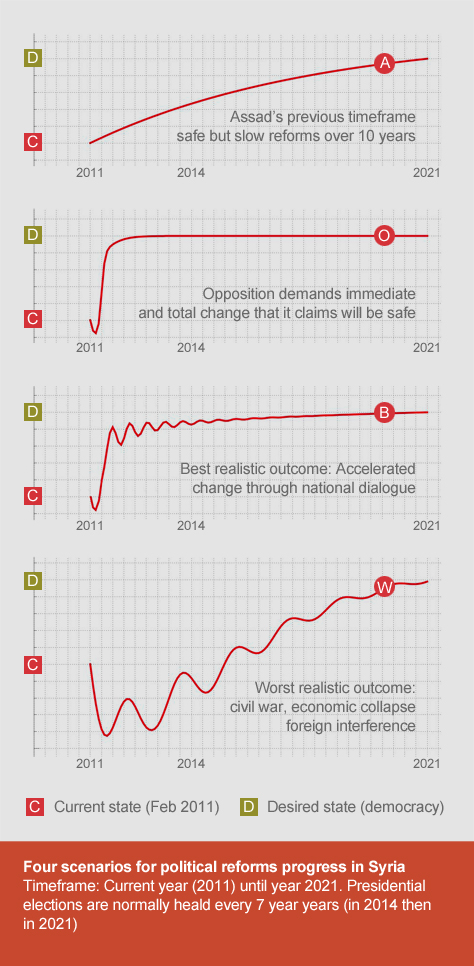Three roads and a fictitious highway to democracy
Saturday, January 14th, 2012 | A post by Camille Otrakji
Here are four different scenarios for rate, direction and extent of change in Syria:
1) Before protests started, President Assad originally wanted to try to be re-elected in 2014 for another 7-year period that ends in 2021. Since the ongoing pressure of dealing with a highly hostile American (Bush) and French (Chirac) administrations, and heir numerous international and Arab allies, started in 2008 to ease, Assad paid more and more attention to economic reforms. He told visiting Westerners who asked him about political reforms that he will tackle those at the slowest and safest pace but will focus on accelerating economic reforms. He explained that he learned from talking to ordinary Syrians that their main concern is their standard of living; jobs, income, housing, and education.
Even if this were true, the Arab Spring eventually reached Syria and young Syrians today are very much interested in political reforms and they would like to see them taking place at a faster pace. The president’s previous plan to start political reforms near the end of his 2014-2021 term (see curve [A] below) is probably not practical anymore. With the exception of die-hard regime supporters, most Syrians now seem to be willing to take some risks for sweeping reforms, although there is disagreement over the direction, extent and speed of change.
2) Many in the Syrian opposition, like other political oppositions elsewhere, believe that everything can be changed if the right people are in control. They find President Assad’s current accelerated pace to be not fast enough and they give the impression that everything will be fine and Syria will have democratic elections soon after the overthrow the regime. Chants of “the Syrian people are one” suggest unity of hopes and goals among the Syrian people that will unite everyone against the regime and for speedy democratic changes. (see curve [o] above).
This scenario is also not realistic. Change will not be as smooth if the opposition insists on the overthrow of a regime that many Syrians, civilians and army, still support
3) The most promising scenario is the one where the President and the reform-compatible parts of the regime work with the opposition to reach successive agreements regarding all areas in need of major reforms in Syria. National dialogue taking shape in a newly and freely elected parliament and a new coalition government is the only realistic way to minimize resistance to change and to take the widest range of opinions into account before drawing the shape of future Syria. Maximal demands have no chance of appealing to all Syrians. Those participating in national dialogue need to understand that they cannot impose their extremist positions on others. (see curve [b] above). There will certainly be ups and downs. Resistance to change will not disappear overnight. Therefore, setbacks should not be used as an excuse to conclude that the regime is not serious and to boycott or walk out of Parliament or a national coalition government.
Under this scenario, a three year period should be sufficient to reach a point where the 2014 Presidential elections are freely contested and where new, and reformed old, political parties are ready to seriously challenge each other’s candidates.
4) The worst case scenario is the one where demonstrations don’t relent and the country splits into different camps (regional, sectarian, or nationalist); the economy continues to suffer until it collapses and foreign powers interfere more intrusively in Syrian affairs (see curve [w] above). Were that to be the course of events, it would set the country back and at best, Syria would need many years to get back on its feet. Permanent division into smaller sect-based states is a real possibility. Idealists and the maximalists in the opposition, eager to replace the current regime, claim that Syrian exceptionalism will protect the country from such a scenario. While a majority of the Syrian people are indeed not sectarian, a significant number of more militant Syrians will still take up arms against each other at some point if dialogue is not started. This scenario (or a downward heading curve) is very real and cannot be brushed off through well staged, feel-good revolutionary slogans and PR stunts. The sizable minority of the population that is compatible with violent expression of its desires and/or fears will not abide by slogans. Their psychology is rigidly shaped through years of experience with their environment. Calls for calm by the secular regime or opposition leaders will have little effect on their actions. Outside powers will promote different sides and will provide them with financing and weapons. The conflict can easily spread to Lebanon and Iraq, and possibly to Turkey.
By Camille Otrakji for The Syria Page







 CreativeSyria
CreativeSyria
Comments (5)
Maysaloon said:
Camille, whilst these four scenarios were possible in March 2011, realistically the regime has gone past the point of no return. In fact there are now only two scenarios, scenario 3 or scenario 4. Scenario 3 could work but only if the regime attempts to regain its credibility, which has been completely lost over the past ten months. The Assad regime used to be friends with Turkey and Qatar and has squandered this political capital through infantile knee jerk reactions. What they must do is take steps to immediately stop the violence and release all political prisoners, and begin steps to greater transparency and accountability. Saying that “many” Syrians support the regime leads us to a circular argument so long as the regime holds a gun above everybody’s heads.
If scenario 3 fails, and I think that highly likely, then scenario 4 is inevitable.
January 15th, 2012, 4:14 pm
syriapage said:
@Maysaloon I agree that scenario 1 and 2 are not feasible. The rist one is too slow for people’s expectations (even most in the “pro regime” camp) and the second was never realistic in nature … complex systems simply do not advance this fast without a serious transient state full of turmoil that is correlated in its swings to the speed of change that a country’s leadership decided to try to adapt.scenario 4 is hell … only Syrians who are blinded by their egos would not mind it.Scenario 3 is the answer … it is a compromise in speed between “too slow” and “too risky” that different Syrians demand (or fear).
January 16th, 2012, 4:57 pm
AIG said:
Alex,
How can you have the internal debate necessary for 3 if you don’t allow freedom of speech? If Assad is serious, he needs to make at least this reform. If he doesn’t, only scenario 4 is left. One could also argue that he must release all political prisoners, because otherwise there is no dialog, just one side pointing a gun at the other. Freedom of speech is not a maximal demand. The ability to talk your mind without being thrown in jail is a basic thing in a democracy.
January 16th, 2012, 5:53 pm
syriapage said:
@AIG There should be freedom of speech, I agree. But we are already half way there … if you spoke Arabic you would realize that there are now many Syrians living inside Syria and advocating the end of the regime. There is much more tolerance now to criticism and even some tolerance for calls for ending the regime if you don’t appear to be a highly energetic trouble maker (from the regime’s perspective). I think, as you can see in my other article, freedom of speech is achievable more easily than the other aspects of human rights or fighting corruption.
January 17th, 2012, 8:33 am
AIG said:
@syriapage Alex,
50% does not cut it. Even the “energetic” people should not be thrown in jail. Furthermore, freedom of speech means that there are non government media such newspapers, radio stations and tv stations (local ones). It means allowing the foreign press in.
It must be clear that the regime cannot intimidate anyone any more into shutting up, and the only party that can make this clear is the regime.
January 17th, 2012, 2:56 pm
Post a comment